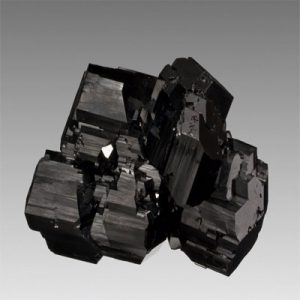Schorl (Tourmaline)
Schorl is the black variety of Tourmaline. It is colored black by the presence of iron. Schorl may also be dark bluish black and dark greenish black. Schorl is the most common mineral in the Tourmaline Group that also includes Buergerite, Dravite, Elbaite and Uvite. All Tourmalines form similar crystals because they are isostructural, meaning they share the same internal crystalline structure.
In addition to being found as independent mineral crystals, Schorl is also found as long thin crystal inclusions in Quartz, forming “Tourmalinated Quartz”. These black crystals, or “needles”, create very attractive and collectable Quartz gems.
The name Schorl may be derived from Zschorlau, the name of a village in Saxony, Germany which was named Schorl, or Schürl, prior to 1400 AD. The name may have come from the Old German SchÄurl or Schürl, of uncertain derivation, perhaps meaning impurities because Black Tourmaline was abundant in a nearby tin mine which also contained Cassiterite.
The name Tourmaline is from the Singhalese word tourmali, meaning mixed colored stones because Tourmalines were often confused with other gems because of the variety of colors. Tourmaline is the name given to a family of related minerals, all having the same basic crystal structure but varying widely in chemical composition. Tourmaline comes in just about all colors including colorless (Achroite) and black (Schorl) with many names given to the many other colors.
| Crystallography: | Trigonal – Ditrigonal Pyramidal |
| Crystal Habit: | Crystals prismatic to acicular, or may be flattened along [0001], with prominent trigonal prism and pyramid, to 1.5 m. Commonly hemimorphic, and striated [0001]. Also radial, fibrous, and massive. |
| Twinning: | Rarely on [1010], [4041]. |
| Cleavage: | [1120] very Poor, [1011] very Poor |
| Fracture: | Uneven to Conchoidal |
| Tenacity: | Brittle |
| Hardness (Mohs): | 7.0 |
| Density: | 3.18 – 3.22 (g/cm3) |
| Luminescence: | None |
| Radioactivity: | Not Radioactive |
| Other: | Piezoelectric and Pyroelectric |
| Color: | Black, Brownish Black, Greenish Black, Bluish Black |
| Transparency: | Opaque |
| Luster: | Vitreous to Resinous |
| Refractive Index: | 1.635 – 1.672 Uniaxial ( – ); under strain may show slight Biaxiality |
| Birefringence: | 0.0270 – 0.0320 |
| Dispersion: | 0.017 |
| Pleochroism: | Very strong; O = yellow-brown; E = pale yellow, pale brown |


